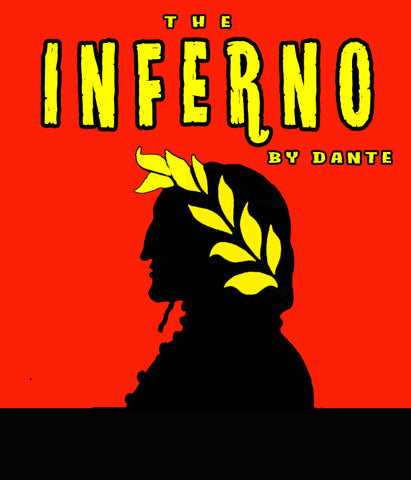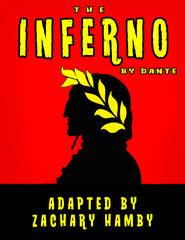
Dark, dismal, and demented—these are all words that describe Dante’s Inferno, one of literature’s most bizarre concoctions. A trip through Hell may seem like an awkward topic to navigate, but don’t abandon hope all ye who enter here: Teaching the Inferno is one of my favorite units of the year. So here are five reasons to teach Dante’s Inferno.
- It’s incredibly morbid and disturbing. This might not seem like a selling point to some, but grabbing students’ interest is getting harder and harder (if you haven’t noticed). Thanks to Smartphones, Netflix, and other addictions, teenagers have the attention spans of fruit flies. How do we combat this? Teach them the most morbidly engrossing poem ever written. Dante’s Inferno, just like a car wreck, brings out the worst in us—we hate to look, but we want to look all the same. In the same group of students I will have some who are appalled by the content and others who can’t get enough, but none who are bored. They are all interested to see what grisly sights wait just around the corner for Dante to encounter. It’s ye olde gross out, but, hey, if it gets them interested in literature, we’ve won a victory!
- Dante’s journey is actually a metaphor for the progress of the human soul. Dante begins by showing us the worst of the worst in Hell—the human race’s deepest depravity—and slowly works through the renunciation of sin and the divine-like qualities to which human beings can aspire. So if you think Dante was totally a sadist and just became a writer so he could put his enemies in eternal torture, think again. Dante saw hope for mankind. Although Inferno is the most widely-read section of The Divine Comedy, we can’t forget that Dante also journeys through Purgatory, where sin is renounced, and Paradisio, where the heavenly souls rejoice. Dante the pilgrim (the poem’s main character and not exactly the author, Dante the poet) learns about himself as he continues his journey upward—recognizing his evil tendencies and thinking about how to neutralize them. The whole poem’s intent is to instruct us how to live the best life we can here on earth, and that’s a useful lesson!
- Dante’s Inferno is a peek inside the thoroughly medieval mindset. Dante’s concept of religion is firmly entrenched in the Middle Ages, where there was only one church, and the pre-Reformation church was a far cry from any form of the Christian church today. Learning about the various corruptions of the medieval church is both interesting and instructive. (Buying off your sins?) Dante puts plenty of corrupt churchmen in Hell, which shows that he was aware of this corruption. The poem is thoroughly medieval in other ways, too. The most notable example might be Dante’s legendary love for Beatrice, a woman he only met twice in her short life. Dante’s love for Beatrice serves as one of the most famous examples of courtly love, a medieval concept where lovers loved from afar (even when they may or may not have been married to other people). It’s a style of romance that is interesting to learn (and possibly giggle) about.
- The poem features a laundry list of allusions. Dante was well-read. Not only will the reader encounter hundreds of characters and grotesque creatures from Greek and Roman mythology—arrow-shooting centaurs, Charon the Boatman, three-headed Cerberus—but also notable ne’er-do-wells from the Bible and European history. Keeping up with all these allusions is enough to make your head reel, but it’s also part of the fun. Perhaps the most interesting are Dante’s famous Italians that he places into Hell. Paolo and Francesca were a famous set of adulterers, and their portion of Inferno, where they are caught up in the whirlwind of the Lustful, is one of the most popular. Count Ugolino in the lowest level of Hell is gnawing at the head of his enemy, who sealed him and his family up in a tower to die.
- Dante’s infernal imagination and imagery. The figurative becomes literal in Dante’s If sinners were cold to their fellow man, in Hell they are trapped in frozen slush. Those who were snake-like frauds in life literally turn into snakes in the afterlife. Flatters are trapped in a river of feces. (Yes, you read that right.) It’s an ingenious idea that Dante carried over from Greek mythology, where a few famous malefactors were sentenced to punishments that fit their crimes in life. Dante’s punishments are creative and precise. In his concept of God’s divine justice, no one is punished more or less than they deserve. All of the Wrathful might be blubbering in a river of boiling blood, but some are further submerged than others—based on the magnitude of their sin.
Bonus: I’ve also heard an interesting theory that Roald Dahl based Charlie and the Chocolate Factory on Dante’s Inferno. Think about it. Each greedy child is punished in a way that mirrors his or her particular sin. Interesting, huh? For more on that, check out this video.
I hope these suggestions have given you some reasons to descend into Hell with Dante. If you are planning to read the whole poem with your students, I recommend John Ciardi’s translation of Dante’s Inferno. It is one I have used in class multiple times.
 If you would like a fresh approach to teaching the poem, you might try the script-story version available on this site. This download also comes with three reading passage worksheets that analyze the original poem and another work by Dante, wherein he tells the story of meeting Beatrice for the first time. For more information click here.
If you would like a fresh approach to teaching the poem, you might try the script-story version available on this site. This download also comes with three reading passage worksheets that analyze the original poem and another work by Dante, wherein he tells the story of meeting Beatrice for the first time. For more information click here.

John Ciardi’s translation is the one I have taught, and it worked well for high-schoolers!
I have long wanted to teach Inferno. I have studied Dante for many years, and though I do not have much Italian, I have read no less than five translations of The Comedy. In fact, next to Chaucer, there is no medieval text I would rather teach, but I have two concerns: 1) My school is an international school that hosts many muslim students, and the the portrait of Mohammed in Canto 28 is not flattering. In fact, I worry that it might be the source of tension. 2) Should I choose to teach Dante, which translation do you recommend? I have Longfellow’s (too antique), Sayers’ (better but ditto), Sinclair’s (Would rather not teach it in prose), Musa’s (what I am leaning toward in terms of clarity and cost—Penguin Classics) and Pinsky’s (beautiful, but not as straightforward as Musa’s and expensive).
I have long wanted to teach Inferno. I have studied Dante for many years, and though I do not have much Italian, I have read no less than five translations of The Comedy. In fact, next to Chaucer, there is no medieval text I would rather teach, but I have two concerns: 1) My school is an international school that hosts many muslim students, and the the portrait of Mohammed in Canto 28 is not flattering. In fact, I worry that it might be the source of tension. 2) Should I choose to teach Dante, which translation do you recommend? I have Longfellow’s (too antique), Sayers’ (better but ditto), Sinclair’s (Would rather not teach it in prose), Musa’s (what I am leaning toward in terms of clarity and cost—Penguin Classics) and Pinsky’s (beautiful, but not as straightforward as Musa’s and expensive).